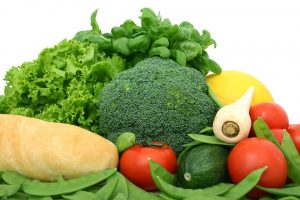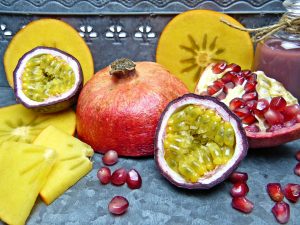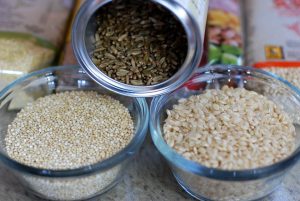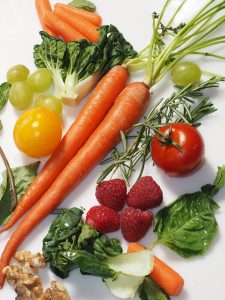Why Is Fiber Healthy?
When we talk about a plant-based diet, we often highlight the importance of fiber. We’ve heard time and again from nutritionists and doctors that fiber is essential for our daily intake. But why is fiber healthy?

Americans today are not getting nearly enough fiber. While the official recommendation is 25 to 30 grams per day most Americans, on average, get only 15 grams of dietary fiber. So, it shouldn’t be too surprising to see problems like obesity or diabetes rearing their ugly heads nationwide.
One of the ways to motivate people to include more fiber in their diet is to explain really how good it is. And that’s exactly what we’re going to cover in this article.
What is Fiber?
Fiber is a type of carbohydrate that’s indigestible in your body. It’s a naturally occurring nutrient in plant-based whole foods.
This is how fiber is interesting because it doesn’t even get digested or absorbed but still does some great things for you as it passes down the digestive tract.
While it’s part of total carbs in a food, you’d typically see fiber listed separately on nutrition labels. This is because it’s sort of a class of nutrients on its own. Also, with fiber being healthy and many carbs not so much, companies want you to know how much fiber there is.
Fiber is classified as soluble or insoluble:
- Soluble Fiber: Soluble fiber is dissolvable in water. When it goes into your digestive tract, it dissolves in the water and becomes a gel-like substance.
- Insoluble Fiber: Insoluble fiber does not dissolve in water or any other fluid and comes out intact from your body.
Typically, on foods, you won’t see soluble and insoluble fiber distinguished. The amount varies by the kind of food. This is why it’s important not to just rely on a single fiber-rich food but to diversify it, so you get both of these types and their benefits.
Which Foods are High in Fiber?
If you know which foods are naturally high in fiber, you can make better choices with every meal. You can even add some fiber to your diet with some fiber-rich snacks.
Those following a whole-food plant-based diet would naturally get more than enough of this amazing nutrient.
But if you really want the list, here are some foods high in fiber:
Vegetables
Vegetables, as a whole food, are rich in fiber. While the actual amount varies, most vegetables do offer a good amount. Whether you eat them raw or cooked in a meal, these colorful floods will help you reach your daily intake.
Here are some fiber-rich vegetables and the amount of fiber they contain:
| Vegetable | Fiber | Daily Value |
| Green Peas (1 cup) | 8 g | 32% |
| Sweet Potato (½ cup, mashed) | 4 g | 16% |
| Broccoli (1 cup, cooked) | 4.1 g | 16.4% |
| Artichoke (1 large) | 9 g | 36% |
| Pumpkin (½ cup, canned) | 3.6 | 14.4% |
Fruits
Everyone knows fruits are a great source of fiber. They contain natural sugars, so are typically high in carbs, too. However, they balance those out with their high fiber content.

| Fruit | Fiber | Daily Value |
| Pear (1 medium-sized) | 6 g | 24% |
| Raspberries (1 cup) | 8 g | 32% |
| Passionfruit (1 cup) | 25 g | 100% |
| Apple with Skin (1 small) | 3.6 g | 14.4% |
| Banana (1 medium) | 3.1 | 12.4% |
Beans
Beans and fiber go hand in hand. While you can snack on fruits, you can use beans for your main meals to cover your fiber intake requirements. Plus, they are super cheap, so easy on the pocket.
| Beans | Fiber | Daily Value |
| Kidney beans (½ cup) | 6 g | 24% |
| Lima beans (1 cup) | 9 g | 36% |
| Black beans (1 cup, cooked) | 7.5 g | 30% |
| Lentils (½ cup) | 8 g | 32% |
Whole Grains

You can also get your fiber fix in the morning with some healthy breakfast cereals. Whole grains are rich in fiber as opposed to their processed flour counterparts.
| Vegetable | Fiber | Daily Value |
| Oatmeal (1 cup, plain) | 4 g | 16% |
| Quinoa (½ cup, cooked) | 2.6 g | 10.4% |
| Whole wheat (2 biscuits) | 6 g | 24% |
| Brown rice (1 cup, cooked) | 4 g | 16% |
Nuts and Seeds
If you’re looking for healthy snacks with fiber, nuts and seeds, definitely make the cut. Here’s how much fiber common nuts and seeds have:
| Vegetable | Fiber | Daily Value |
| Walnuts (1 ounce) | 1.9 g | 7.6% |
| Almonds (1 ounce) | 4 g | 16% |
| Chia seeds (1 ounce) | 10 g | 40% |
| Flaxseeds (1 ounce) | 6 g | 24% |
| Peanuts (1 ounce) | 2.6 | 10.4% |
Why Is Fiber Healthy?
Let’s get down to business and talk about why and how fiber is healthy for us. There are tons of benefits of fiber, with most of them related to your digestive health. But it goes way beyond that.
Healthy Gut
Perhaps the most prominent benefit of fiber is that it promotes a healthy gut. This benefit mainly comes from insoluble fiber, which adds bulk to the waste. It improves the digestion of other nutrients, so they are fully absorbed.
More importantly, fiber flourishes the microbiome in your digestive canal. This microbiome or healthy gut flora (bacteria) is necessary for digestion. And, as the fiber ferments in your gut, it produces fatty acids that are fiber-rich and, in turn, lower inflammation.
This paper, published in Cell Host and Microbe, explores the relationship between dietary fiber and gut microbiota. It includes extensive scientific evidence that proves fiber is essential for humans.
Anti-Inflammatory Effect
As mentioned above, fiber also has benefits against inflammation. Inflammation, which is an immune response, is a symptom of many chronic diseases. Fiber can target it, especially when occurring in the digestive tract.
The main substance in fiber that adds this benefit is butyrate, according to Dr. Michael Greger of NutritionFacts.org. So this indigestible carb may also be beneficial in treating the symptoms of diverticulitis and IBS.
More Regularity
If you’ve ever been to Germany, you’ve probably seen one of those toilets with a bowl toward the end and a flat surface to collect your business. There’s a lot of debate about what the purpose of that design is. But many people believe it was used in old Germany as a way to examine the stool before flushing.
Whether that’s true or not, this much is true that your stool can tell a lot about your health. Those who eat the recommended amount of fiber is, well, more regular. It’s a sign that their gut is doing its job well and doesn’t have any infections or other digestive issues. Fiber can help prevent constipation, too.
Better Blood Sugar Control
The soluble fiber in whole foods helps maintain blood sugar levels at healthy levels. This is good news for those at risk of type II diabetes or those who already have it. With more fiber in their diet, they can improve their insulin response and prevent the severity of the disease.

In fact, fiber can also help prevent type II diabetes. A meta-analysis of sixteen research studies about fiber intake and diabetes risk showed that those who ate more fiber had the lowest risk. It also mentions that the most significant fiber for the prevention of diabetes is cereal fiber.
Prevention of Heart Disease
Fiber isn’t just good at reducing the odds of diabetes, it may also help prevent heart disease, which makes it heart-healthy. For some perspective, a BMJ review of 22 studies established that for every seven grams of fiber, the risk of heart disease reduces by nine percent.
So why is that? The answer lies in fiber’s action on cholesterol. It has the ability to absorb lipids and reduce the amount of bad cholesterol in your body. Cholesterol, as we know, blocks the arteries and causes a range of heart diseases.
Healthy Weight
Fiber also enjoys a good reputation for promoting a healthy weight. It can, in fact, help overweight and obese individuals lose weight in a healthy way. What does it mean to lose weight healthily?
Well, fiber, in particular soluble fiber, increases the time it takes for food to complete digestion. Furthermore, fiber helps you feel filled up, which reduces your hunger for eating more than you probably should.

Fiber is so good for weight loss that you can lose weight just by increasing fiber in your diet. You don’t really need to restrict calories and avoid a wide range of foods. If you follow a plant-based diet, eat more fiber, you’ll start losing weight in just one or two weeks.
This is backed by science, as a study in the Journal of Nutrition showed that fiber alone can induce weight loss regardless of caloric restriction.
Another reason why it’s good for weight loss is that fiber binds with the sugars and starchy carbs, reducing the actual absorption of these not-so-great nutrients. So if you’re someone who has a hard time staying on processed carbs and sweets, you can at least balance them off with more fiber in your diet.
Cancer Prevention
Fiber can reduce your chances of certain cancers, including colorectal cancer and breast cancer. Just 10 g of fiber can reduce the risk of breast cancer by five percent, according to the Annals of Oncology study.
Fiber on its own can also help prevent these cancers. However, even more powerful are certain antioxidants you’ll find in vegetables and fruits that are high in fiber. So you also get those antioxidants alongside fiber.
Natural Cleanser
Fiber doesn’t just promote good bacteria in your gut, it also cleanses out the toxins in your digestive tract. It can get rid of bad fats and even ext, but if you keep eating fiber regularly, you’ll get there.
Fiber’s toxin-cleaning properties are so good that it’s also popular in skincare products. In addition to that, prebiotic fiber is found to enhance the availability of certain minerals.
How Much Fiber Per Day?
It can be confusing sometimes as to how much fiber do you really need. Now that you understand why is fiber healthy, it’s equally important to understand how much of it you need every day.

The ballpark figure is between 25 and 30 grams per day. The actual number may vary depending on your age and sex. For instance, adult men should ensure a daily intake of at least 30 g. But you can also go higher.
If you’re looking for some inspiration for how to include that much fiber in your diet, check out this detailed guide from WebMD for eating 37 g of fiber in a day. You can also find a comparison of high fiber and low fiber foods to make the right call.
Wrap Up
Fiber is one of the reasons why a plant-based diet is so healthy. The benefits of fiber deal with so many of the rampant health issues in the world. From obesity to diabetes to gut problems, everything is linked with the low-intake of fiber.
The best way to include more fiber in your diet is to consume solely plant-based whole foods (emphasis on the whole). Furthermore, follow the guideline set by the USDA, as well as those outlined in the WebMD post, to get your fiber fix every day.











